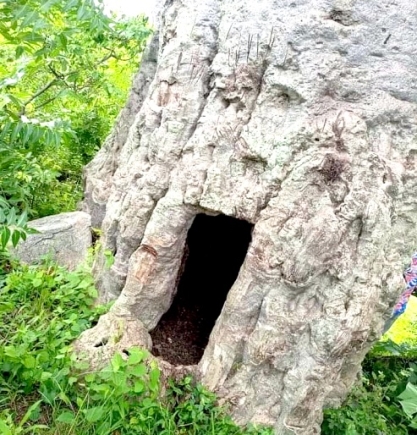Located about 30 minutes from the Wa Municipality in the Upper West Region is Busa, a suburb which hosts a giant baobab tree that has been in existence since the 12th Century.
The giant tree has a door carving at its base and a window carving atop with a big hole inside it.
The inside looks hollow and spacious, with a relatively cool temperature.
Though there is no staircase inside the hole of the giant tree, some adventurous tourists manage to climb to the window-like space at the top of the tree, ostensibly to kill their curiosity.
The size of the hollow in the tree can also admit about 10 people.
History has it that the tree was discovered by early settlers of the community around the 12th Century as a place to seek refuge to be strategically positioned to attack their enemies during the days of war.
However, the site which is located at the outskirt of the Busa community is undeveloped.
It is in the bush surrounded by other grown trees such as the shea tree.
Though not developed, a number of tourists from various parts of the world throng the area, often to have a feel of nature.
A tour guide, Aziz Pelpuo, in an interview, narrated that the early settlers arrived in the community during the days of war and discovered the giant baobab tree.
"They first sought refuge in the tree and realised the enemies couldn't identify them.
They noted that each time they entered the hole they became invisible to the enemies, so they took it as a place of worship, where they offered sacrifices and poured libation," he said.
He indicated that the site had the potential to boost local tourism when properly developed.
Mr Pelpuo, therefore, appealed for the development of the site and many others to help boost local tourism and generate revenue for the assemblies.
Development
The Upper West Regional Manager of the Ghana Tourism Authority (GTA), Moses Ndewin Ndebugri, told the Daily Graphic that the GTA had taken note of the site and was working around to develop it.
"Early this year, I visited the site to have a look at it and also engage the community members on how we can possibly develop it," he said.
He said though there was no documented history about the site, various accounts of the elders of the community indicated that the tree, which was discovered some centuries ago, served as a safe haven for the people during wars.
"We intend to demarcate the place and develop it with various facilities to make it a standard site so that the community members can reap its full potential," he stated.
Sacred
An elder of the community, Iddrisu Lara, said the people of the community revered the sacred site and had been protecting it from all manner of harm because it was bequeathed to them by their ancestors.
During the days of wars, he explained that each time the warriors were preparing for battle they were brought to the sacred site for fortification for about a week to enable them to become invisible in the battlefield.
Aside from the tourism potential, he said the bark, roots and leaves of the tree were currently used for medicinal purposes by the inhabitants.
Visits
Checks by the Daily Graphic showed that about 20 guests from all walks of life, including researchers, visit the site each month to have a feel of it.
A reveller, Adam Mahama, who accompanied his expatriate friends to the site, said he got to know about the baobab tree from social media.
He said "I am amazed by the interesting story behind the existence of the tree and I hope to come back another time to have a feel of it."
Writer's email: mohammed.fugu@graphic.com.gh

